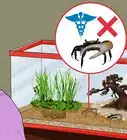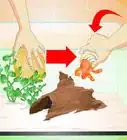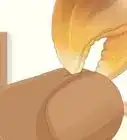This article was co-authored by wikiHow Staff. Our trained team of editors and researchers validate articles for accuracy and comprehensiveness. wikiHow's Content Management Team carefully monitors the work from our editorial staff to ensure that each article is backed by trusted research and meets our high quality standards.
There are 9 references cited in this article, which can be found at the bottom of the page.
This article has been viewed 44,192 times.
Learn more...
Brackish water fiddler crabs are a good species of crab to keep as a pet, since they are relatively hardy and fun to watch. Although they're native to the Atlantic seaboard and Gulf Coast of the U.S., they are kept in captivity around the world.[1] Fiddler crabs are relatively small: adults seldom grow larger than 33 millimetres (1.3 in) across.[2] However, the large claw on adult males can grow as long as 2 inches (5.1 cm).[3] Like other species of crabs, fiddler crabs should be kept in a glass or plastic tank and fed regularly. All of the items you need to care for fiddler crabs should be available at a local pet-supply shop.
Steps
Setting up a Fiddler Crab Tank
-
1Provide a 10 US gal (38 L) glass tank for your crabs. Fiddler crabs need plenty of room to live in. As long as you’re only caring for 4 (or fewer) crabs, you can keep them in a 10 gallon (37.9 L) aquarium tank.[4] Since fiddler crabs are social, it’s best to care for more than 1. However, don’t keep more than 1 male in a tank, or frequent fights may break out. [Image:Care for Brackish Water Fiddler Crabs (Uca Minax) Step 1 Version 2.jpg|center]]
- Fiddlers are escape artists, so make sure purchase a tank with a tightly-fitting lid. Keep the lid shut at all times, except for when you’re replacing the water and feeding the crabs.
- If you purchase more than 4 crabs, opt for a 20 US gal (76 L) tank. Purchase glass tanks of all sizes at a local pet-supply store.
-
2Mix different textures of sand together to form the substrate. Fiddler crabs tend to dig burrows in sand, so the substrate should be sturdy and hold together. The best way to achieve this effect is to purchase sands of 2–3 different consistencies (fine, coarse, very coarse) and blend them together. Pile the substrate at least 8 in (20 cm) deep so the crabs can dig and burrow.[5]
- Purchase sand of 2-3 different consistencies at a home-improvement store, hardware store, or home-supply store. Or, if you live near the beach, take a walk and collect coarse and fine sands yourself.
- To ensure that the substrate doesn’t dissolve into the water, you can line the bottom of the tank with a single layer of pebbles or pea gravel.[6]
Advertisement -
3Slope the substrate down on one half of the tank. Your fiddler crabs will spend plenty of time in the brackish water that you'll provide, but also need to be able to access dry land when they want. So, pile the substrate highest on 1 side of the tank, and slope it downward at about a 45° angle toward the side that will contain the water.[7]
- At its highest, the substrate should be between 7–9 inches (18–23 cm), and at its lowest, it should reach less than 1 inch (2.5 cm) high. The downward slope should end at about the halfway point of the tank.
-
4Set 4–6 plants, rocks, and other hiding places into the tank. Fiddler crabs like to interact with their environments and will be bored if there are no objects to hide behind in their tank. On the substrate side of the tank, position up to half a dozen decorative plants, rocks, pieces of driftwood, or plastic hiding huts.[8] Plants that work well in a brackish tank include moss, anubias, most types of fern, moneywort, and brookweed.[9]
- Purchase these items at a local pet store or plant nursery. Or, take a walk along a beach and pick up a few stones and pieces of driftwood.
- Use chunks of granite or another hard stone in your crab tank. Avoid using soft sandstones or limestones in the tank, since they may erode over time.
-
5Pour slightly brackish, dechlorinated water on the other side of the tank. Fiddler crabs in nature live on ocean shores where the water is brackish but not as salty as seawater. Purchase marine salt at your local pet store and mix it with dechlorinated water to create brackish water. [10] To make brackish water, mix 1/4 cup (50 g) of marine salt into 2 gallons (7.6 L) of water. Pour the saline water into the other side of the tank from the sand until it’s 1 inch (2.5 cm) deep.[11]
- Your fiddler crabs will not survive if you use fresh water or pure seawater. The crabs will die in freshwater and saltwater in less than 2 weeks.
- Always use marine salt when making brackish water. Freshwater aquarium salt will not work.
Maintaining and Cleaning the Tank
-
1Keep the tank’s temperature between 75–82 °F (24–28 °C). The tank’s temperature is critical to the crab’s wellbeing. Clip a thermometer onto the glass inside the tank so you can easily see the interior temperature. To keep the temperature consistent, purchase a reptile-specific heat lamp. Attach it to the side of the tank (over the side with substrate) to create a hot spot for the crabs.[12]
- If the in-tank temperature falls below this range, your fiddler crabs will hide in the sand and may die.[13]
-
2Spray mist into the tank every 2–3 days to keep humidity levels high. Fiddler crabs are used to high-humidity environments and shouldn’t be kept in a dry tank. To keep the tank humid, fill a plastic spray bottle with dechlorinated water. Twist the spray-bottle nozzle so it shoots out a fine mist, and spray this over the substrate side of the tank at least 2 times a week.[14]
- Without enough humidity in the tank, fiddler crabs will be unable to breathe properly.
-
3Remove and replace 100% of the water on a weekly basis. Since fiddler crabs eat and excrete in their tanks, the water will quickly get dirty. Use a water bucket and a flexible tube or hose to siphon the dirty water out of the bottom of the tank. Then, mix another batch of brackish water, and refill the tank with the new, clean water.[15]
- If the water is left unchanged for too long, the crabs could develop diseases and, in serious cases, die.
Feeding Your Fiddler Crabs
-
1Feed your fiddler crabs a variety of vegetable foods every 2-3 days. Pet stores sell vegetable-based food pellets that are specifically designed for crabs. Give each of your crabs 1 small handful of these pellets daily. Fiddlers also eat a variety of fibrous vegetables and greens, so give each crab 4–5 vegetable slivers each week.[16]
- Fiddlers like a variety of veggies, including cucumbers, green beans, algae (including dried algae wafers), and blanched spinach zucchini, spinach, or peas.
- Fiddler crabs have small mouths. To make vegetables easier for them to eat, cut the veggies up into slivers that are not more than 1⁄8 in (0.32 cm) wide.
- If your crabs leave food behind after they’ve finished eating, decrease the amount of food you give them each day.
-
2Give your fiddlers protein at least 3–4 times a week. Brackish water fiddler crabs are scavengers and they eat whatever they can find. Although they can survive on only vegetable food sources, fiddler crabs will thrive when protein is included in their diets. You can give the crabs their protein at the same time you feed them pellets or vegetable-based foods.[17]
- Always set the crabs’ food on the substrate, never in the water. Cut larger items like shrimp and fish into small serving pieces not larger than 1⁄4 in × 1⁄4 in (0.64 cm × 0.64 cm).
- A few times each week, give fiddler crabs a small portion of protein-heavy food including freeze-dried bloodworms, freeze-dried shrimp, freeze-dried krill, or small pieces of fish.
-
3Set a small dish of fresh water on the substrate side of the tank. From time to time, fiddler crabs may wish to wash themselves off in freshwater or may decide that they’d like a drink. Fill a 3–4 in (7.6–10.2 cm) plastic or ceramic bowl with dechlorinated water or bottled spring water. Set the dish in the crabs’ tank on the substrate so that the crabs can easily access it.[18]
- Dump out the old water and replace it with fresh water at least 1 time per week.
Community Q&A
-
QuestionHow long can a fiddler live in an estuary tank?
 Community AnswerIf you take good care of it, it might last a month or so, but more likely it will be about two weeks.
Community AnswerIf you take good care of it, it might last a month or so, but more likely it will be about two weeks. -
QuestionWill aquarium salt work for fiddler crabs?
 Community AnswerNo.
Community AnswerNo. -
QuestionHow do I make the water for the crabs?
 Community AnswerYou can use a small sponge or just cut a piece from a big sponge. Soak it in water, then place in the cage.
Community AnswerYou can use a small sponge or just cut a piece from a big sponge. Soak it in water, then place in the cage.
References
- ↑ http://www.fiddlercrab.info/u_minax.html
- ↑ http://gcrl.usm.edu/public/gulf.creatures/fiddler.crabs/fiddler.crabs.php
- ↑ http://www.edc.uri.edu/restoration/html/gallery/invert/fiddler.htm
- ↑ https://animals.mom.me/care-feeding-freshwater-fiddler-crabs-8639.html
- ↑ https://www.researchgate.net/publication/274408282_Fiddler_crabs_in_captivity_a_real_challenge
- ↑ https://animals.mom.me/care-feeding-freshwater-fiddler-crabs-8639.html
- ↑ https://animals.mom.me/care-feeding-freshwater-fiddler-crabs-8639.html
- ↑ https://www.petguide.com/blog/fish/tips-for-keeping-fiddler-crabs-in-your-brackish-tank/
- ↑ https://www.aquariadise.com/7-hardy-plants-for-a-brackish-aquarium/
- ↑ https://animals.mom.me/care-feeding-freshwater-fiddler-crabs-8639.html
- ↑ https://media.vwr.com/emdocs/docs/scied/Fiddler_Crabs.pdf
- ↑ https://animals.mom.me/care-feeding-freshwater-fiddler-crabs-8639.html
- ↑ https://www.researchgate.net/publication/274408282_Fiddler_crabs_in_captivity_a_real_challenge
- ↑ https://www.ncf.edu/msoi/experiments/fiddler-crabs/
- ↑ https://media.vwr.com/emdocs/docs/scied/Fiddler_Crabs.pdf
- ↑ https://animals.mom.me/care-feeding-freshwater-fiddler-crabs-8639.html
- ↑ https://animals.mom.me/care-feeding-freshwater-fiddler-crabs-8639.html
- ↑ https://www.ncf.edu/msoi/experiments/fiddler-crabs/
- ↑ https://www.petguide.com/blog/fish/tips-for-keeping-fiddler-crabs-in-your-brackish-tank/
- ↑ http://www.edc.uri.edu/restoration/html/gallery/invert/fiddler.htm
About This Article
To care for brackish water fiddler crabs, keep up to 4 of them in a 10-gallon tank, or get a bigger tank if you have more than 4 crabs. Line the bottom of their tank with sand, and slope it from one side of the tank to the other so you can fill half the tank with dechlorinated brackish water. You should also decorate the tank with plants, rocks, and shelters to help your crabs feel safe. To feed your crabs, give them vegetable pellets every 2-3 days and protein 3-4 times a week. To learn how to keep your crabs' tank warm and humid enough, scroll down!
-Step-2-Version-2.webp)
-Step-3-Version-2.webp)
-Step-4-Version-2.webp)
-Step-5-Version-2.webp)
-Step-6-Version-2.webp)
-Step-7-Version-2.webp)
-Step-8.webp)
-Step-9.webp)
-Step-10.webp)
-Step-11.webp)
-Step-14.webp)
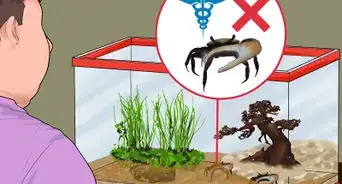
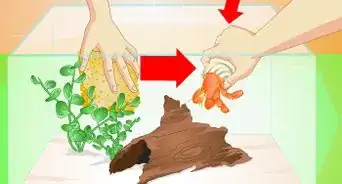
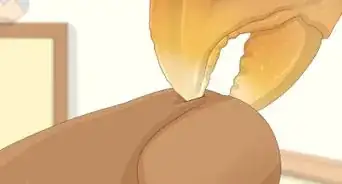
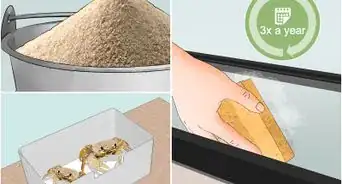

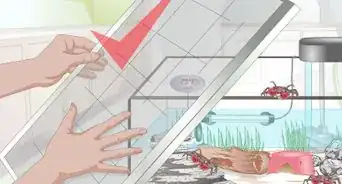
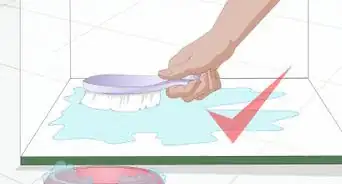
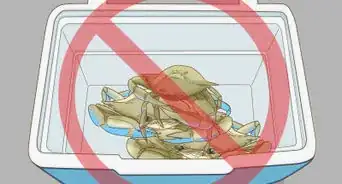
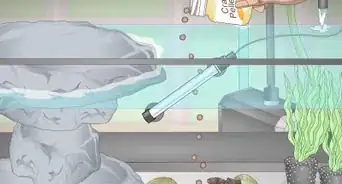
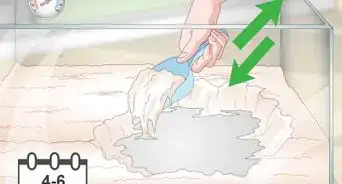

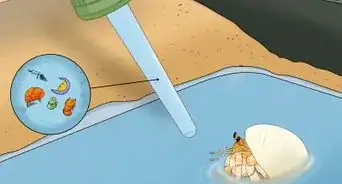
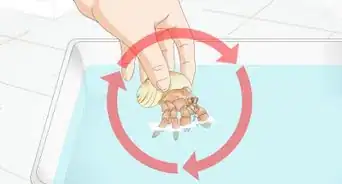







-Step-14.webp)
